For our students: The best way to take notes, according to your learning style

Here's a tricky riddle for you.
What's something everyone knows is an important tool for obtaining good grades, but few hardly utilize? And even fewer actually enjoy doing this one thing.
OK, maybe it's not that great a riddle. Considering this subject revolves around schoolwork, there can be a number of answers. But the one we have in mind is taking notes.
It might be surprising that there are, in fact, multiple ways to take notes. And, depending on your style, there are a right and a wrong way to take notes.
While there are several different methods, we'll focus on the four ideas based on our teacher's suggestions and input. Each has its benefits and downsides, it just depends. All have the ability to customize, so you develop your personal learning style. Check them out:
The "write down what you hear" method

The write-down-everything-as-fast-as-you-can style works for very few, but it seems to be everyone's go-to.
With this approach, you watch a video, read a lesson or hear a lecture and try to write down everything. You'll likely end up short-handing a lot in order to keep up, which means you're and probably not taking the time to comprehend what you're writing.
If you are an incredibly fast typer, maybe you can write down everything you hear. Even then, it's probably best to focus on what you find important.
If you do like to write down most of what you hear in order to have more resources later for studying, there's a workaround.
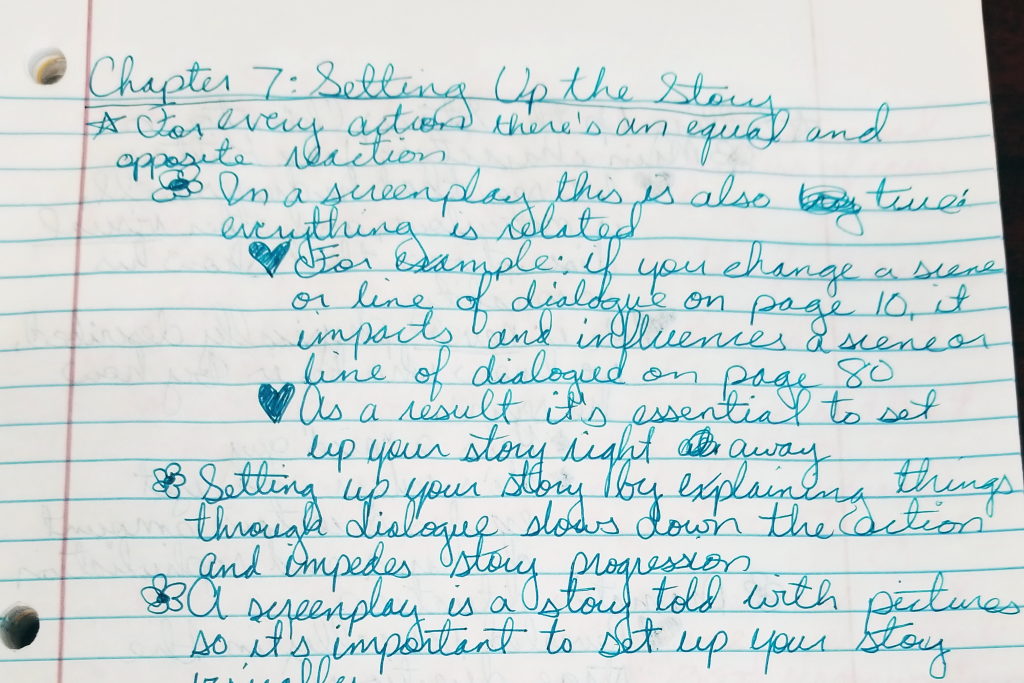
As you're reading through lessons, pay attention to the bolded words, and try to write your own definitions. You can always refer back to the lesson for the actual definition and writing in your own words helps you comprehend and remember.
When to use this note-taking method:
- You're a fast writer/typer and paraphrase well
- You don't mind taking time to thoroughly read through notes later
Why you might not use this method:
- You don't write or type quickly
- You often get stressed about missing key points
- Reading notes is difficult for you and you'd prefer to scan
Visual Outline Method
For these notes, we'll be pretending you're learning becoming a school mascot, Peyton Panther.

Before you head to your tablet or computer for taking notes, you might want to consider the good ol' fashioned notebook. It's believed that physically writing notes helps you retain information better.
It's debated, though, because typing allows you to take more notes since most type faster than they write. The best advice? Try both and see which truly helps you learn.
Another benefit of physical notes is that you get to doodle. Studies saythat drawing pictures that associate with the topic can help you.
If you feel you're more of a visual learner and you enjoy drawing, try out the visual outline method. Here's how you'd format your notes:
- Topic or keypoint
- Sub point
- supporting points (if needed)
- Sub point
- Topic or keypoint #2
- sub point
- supporting points
- sub point
And so on and so forth. Each time you have a new topic or keyword, draw something to go along with it.
For example, let's say you were learning about Peyton Panther. Your notes might look like this:

English teacher Isha Rupal is a fan of the outline method. Her personal customization is what she calls "prioritization." Find what matters and break it down.
Try to keep things mentally and physically organized based on whether I categorize them as big ideas, supporting details, examples of the supporting details, exceptions to the rule, etc. So, as an example, my written notes might look like this:
- Spongebob Squarepants
- Lives in a pineapple under the sea
- Two windows, one door
- Neighbors are Sandy and Squidward
- Works at Krusty Krab
- Best friend is Patrick Star
- Kind of an idiot
- “East? I thought you said Weast!”
- “Is mayonnaise an instrument?”
- Kind of an idiot
- Lives in a pineapple under the sea
When to use this note-taking method:
- During a long lecture with several points of discussion
- You have a hard time paying attention and often find yourself doodling
- You like to paraphase
Why you might not use this method:
- You're a perfectionist and drawing might take too much of your focus
- You don't enjoy drawing
- There are a lot of keywords in the lecture
If it is a keyword-heavy lesson, this method could still work. But you might want to break down your notes a little differently. we suggest this layout:
[/fusion_text][fusion_table]
| Unknown word | Definition | Picture |
|---|---|---|
| Peyton Panther | School mascot, spirit enthusiast |  |
The Cornell Method
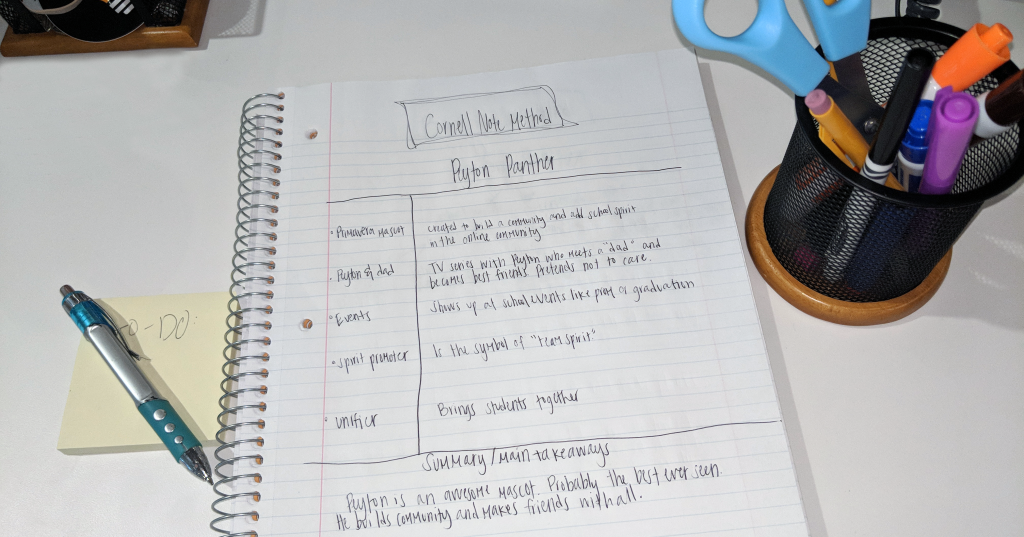
This is a note-taking method that's either loved or hated by most. Some swear by this approach while others find it too constraining.
If you're in a science-based course or going through a lesson with a lot of bold points, this could be the best method. With the Cornell method, you separate your paper into one skinny column on the left, a large column on the right, and a row at the bottom. It's formatted as such:
- Title
- Left column of keywords
- Right column with notes, takeaways
- Bottom row with a summary
If you wanted to take your notes about Peyton Panther using this method, it'd look something like this.
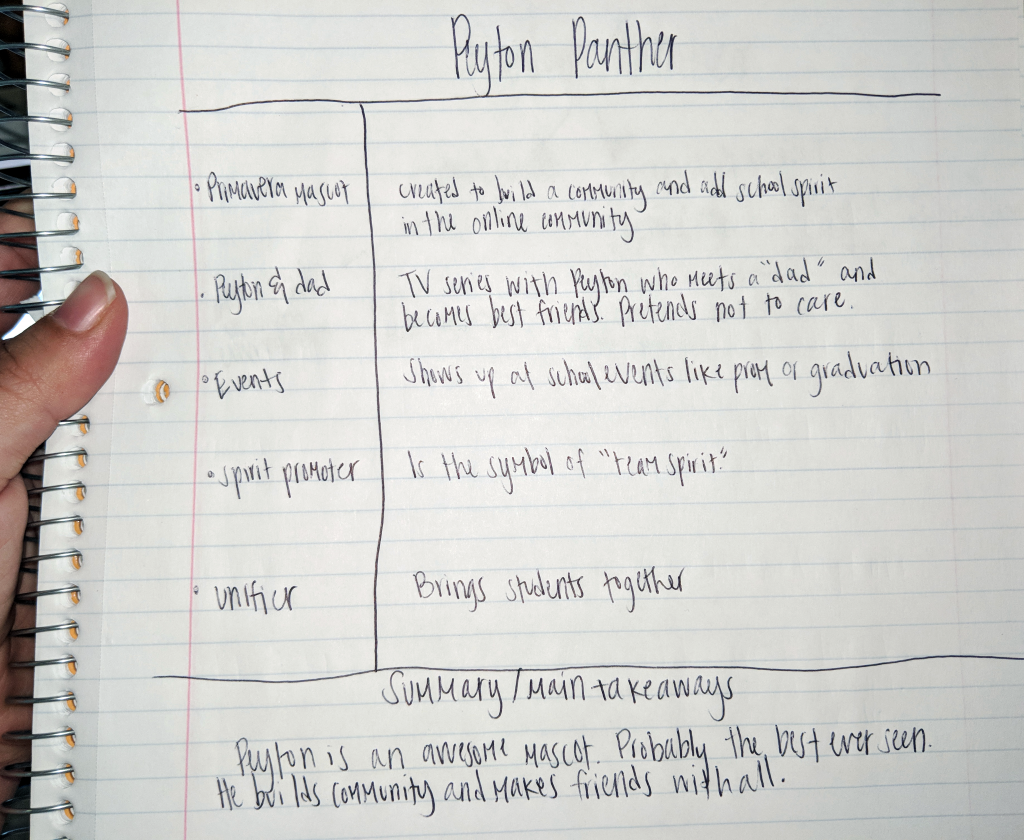
Here's how one teacher customizes the Cornell method:
"I mostly teach middle schoolers so I try and keep it simple when telling them to take notes," said Mr. Welch. "My advice to them is usually to take notes in an organized way that you can easily refer back to and extract information from, but at the same time take notes in a way that is comfortable and fun for you personally. This template leaves that door open for them to organize their thoughts but do it in an interactive and freelance way."
When to use this note-taking method:
- There's a lot of terms and keywords to learn
- You want to memorize keywords or definitions
Why you might not use this method:
- The lesson has several different topics and breaking it down is difficult
- You don't feel confident in scanning and filtering information in lessons
The Branching Method

This method is great for breaking down complex lessons. If you are learning a few different things that relate to each other, like the different nervous systems within the body, this can help you jot down notes in a way that helps you see things a little simpler.
Notice that all these can be written digitally, even if you want to doodle. Use an app that lets you work with a stylus, so you can take notes how you want.
Back to the example of Peyton Panther. If you were learning about the mediums in which one might see Peyton, this is how the branch method would look.
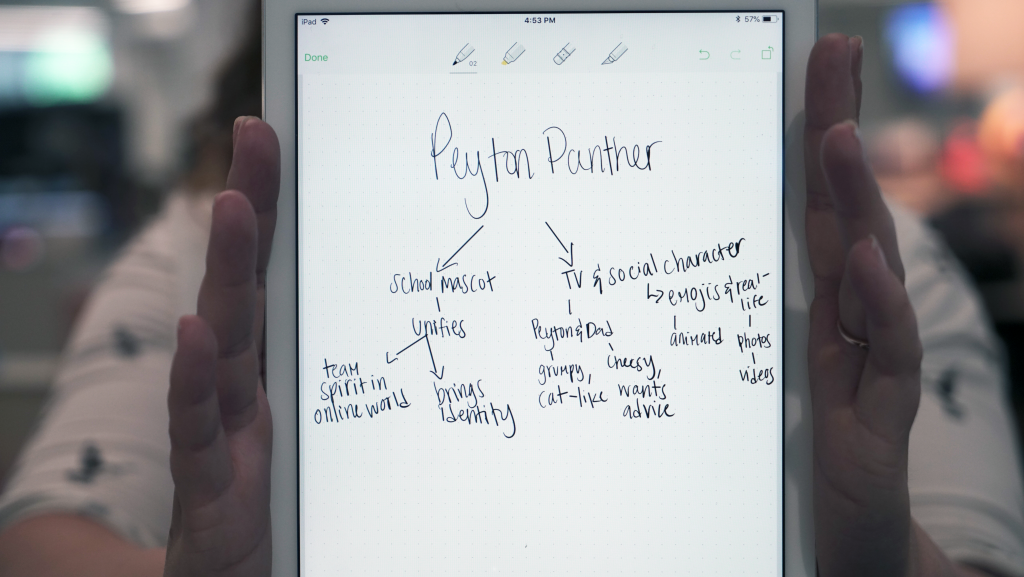
You can also color code topics as you take notes. This will make it easier to review your notes when you go back later.
How to Get Your Child to Focus on Homework and Stop Procrastinating
 You might be a homeschool mom, a traditional school mom or an online school mom. No matter what type of mom you are, there’s one thing you have in common: the homework struggle. And it’s real.
You might be a homeschool mom, a traditional school mom or an online school mom. No matter what type of mom you are, there’s one thing you have in common: the homework struggle. And it’s real.
It happens every day. There’s the ever-piling list of things to do, usually accompanied by the not-so-willing student who needs help staying motivated.
As a parent, you know too well that every decision in school impacts your student’s future. Better grades mean more opportunities, after high school and even in elementary school.
Getting your child to focus on homework can be stressful, but it doesn’t have to be. There are a few easy changes you can implement now to start seeing improvements today. Check out the tips below.
Tips to Help Your Child Focus on Homework
Tip 1: Start With a Small Exercise

Studies show that cardio-based exercises boost memory and thinking skills. Cardio based means doing something that accelerates the heart rate.
If you get your child moving before starting schoolwork, it will get the blood flowing. This will help the brain become more active and ready to focus on homework.
Some exercises could be jogging, riding a bike, playing a sport or even just dancing a bit to some fun music. Anything your student likes to do that’s fast-paced can certainly help the motivation and focus.
Tip 2: Help set a routine
In Elite’s homeschooling and virtual academies, there is the added benefit of a more flexible schedule. With that added benefit comes the need for discipline.
To be successful in courses, it’s best to create a daily schedule for your child. Ideally, your child would put this schedule together with your help where needed. Keep the schedule realistic, including breaks where necessary.
Once a schedule is in place, there’s less guessing. Routines can also lead to reduced stress, as some studies have shown.
This is a custom heading element.
1. Get a planner, or use a free online application
Some tool for your child easily view the daily schedule is important. This can be a physical planner or an app, but either way, it’ll make sticking to a schedule much simpler.
2. Think about the week; include every plan
Have your student list everything they plan to do that week. Does she like to fit in some time to skateboard? Great! Schedule it in. Besides, it might be best to do that skateboarding right before homework. 😉
3. Be Realistic
If your child is more of a night owl, you don’t have to force them to be an early bird and vice versa. Adjust free time and homework time accordingly. Your student might be one who needs frequent breaks in order to work efficiently. If that’s the case, then set a timer for 30 minutes of work with a 15-minute break immediately following.
Whatever works best with your child’s learning style will be a routine you both can stick to. You’ll be able to figure that out as you try new things and test them out.
Tip 3: Gather the necessary items before starting homework
Small disruptors go a long way (we’ll explain that more later).
If your child stops homework to grab a snack or a notebook, he’s going to get distracted.
Make sure your student has all the necessary materials ready to go before starting schoolwork.
If your student is an independent learner or homeschooler, keep a list of teacher’s and guidance counselor’s phone numbers on hand. Also having note-taking materials, the daily schedule and a glass of water will help your child be better prepared to focus.
Tip 4: Establish a workspace
We’re not saying you have to go to the store right now and drop hundreds on a desk, chair and supplies. The workspace doesn’t have to be traditional. But it should be a designated place in order to better focus on homework.
Maybe that place is an office in your home. Or perhaps your child has a fuzzy bean bag in your room that she loves. Whatever you both decide, make it a habit, and make sure it’s a place that’s comfortable to work. After all, that bean bag might be comfy to relax in, but might not be best once your student has a laptop and notebook to juggle.
It can be a good idea to incorporate some fun items to the workspace to help your child be excited to work there. These can be items like photos, music, lotion, candles or a favorite drink.
Whatever is decided, it’s a great idea to separate the workspace from sleep space.
If your child does homework in your bed where she sleeps, it’s likely going to make her want to take a nap rather than do homework. Make sure she studies somewhere you know he won’t get distracted until she finishes homework.
Tip 5: Remove all distractions


A distraction includes anything that deters your student from focusing on homework. This can range from music to a loud sibling.
Let’s take a moment to talk about those smartphones. They’re more detrimental to homework than you might think.
A study showed that having the phone on silent isn’t enough. Small disturbances like a screen notification could increase errors in your work. It also could prolong the time it takes to complete assignments. Here’s why:
As a researcher from the study stated, “Although these notifications are generally short in duration, they can prompt… mind-wandering, which has been shown to damage task performance,” (PsychCentral).
Even just being aware of a missed call, an unread text or another notification causes the brain to lose focus on homework. It knows there is something else to do, and it diverts attention.
We recommend setting all smart devices (phone, tablet, etc) in another room. If your child is able to forget about it, he will likely finish his homework quicker with fewer mistakes.
Tips to Help Your Child Stop Procrastinating
Tip 1: Create Rewards For Motivation
If you know your student has six assignments to complete in a day, then set aside a small reward for each.
Know your student’s weaknesses and turn them into rewards. If she likes to surf YouTube videos or SnapChat with friends, then allow these activities AFTER she’s completed schoolwork, but not until then.
Tip 2: If your child gets bored easily, incorporate more breaks
If your student has a hard time staying focused (like most students), it can cause stress or negative associations if she thinks he has to do his homework all in one sitting. And if your child experiences high stress before starting homework, he’s probably going to have a difficult time not procrastinating.
If that sounds like your child, then implement short breaks. Let him take a short break and color, or turn on a favorite YouTube music video and have a dance fest.
Getting the blood circulating will help your child’s brain and spirit. Nothin’ like rockin’ out to a favorite tune!
Now this is the way to do homework, right?!
By breaking up coursework with small, fun tasks, her brain will have more positive associations. This might help your child dread starting homework less.
Tip 3: Reach out to your guidance counselor
It’s often a forgotten fact that your guidance counselor’s job is to help your student with any academic struggles. If your child has trouble starting her coursework, reach out to your counselor for help. They are state-certified and dedicated to you.
Elite is also readily available to develop personalized learning plans for your child.
Helping your child stay on track with homework is never easy, we know. But by following the tips above, it can become less stressful, and your child will hopefully be able to stay more focused. Learn more about Elite’s faculty and staff here.
We’ll leave you with one last quote:
“You have the power to be as successful as you want to be. Never let others dictate who you are destined to become!” – Brent Woodard, Elite CEO
Here’s what online, homeschool and flex students say are ‘back to school’ essentials

As parents, let’s be honest—
Going back to school shopping is terrible.
It might sound exciting at first, sure. You could spend some quality time with your kiddos and buy them a few new things. But then you get to the store, and there are only two scenarios:
- You’ve started your shopping early. Congratulations! Now you’re struggling through the crowd that’s nothing short of a Black Friday mob.
- You wait to do your shopping, either to avoid crowds or because you’re a procrastinator. Either way, you’re stuck with the bottom of the barrel, meaning you get to hear the whines of your children who don’t want that outdated Lisa Frank trapper keeper. But it’s all that’s left over.
It’s a much nicer thought than reality.
And that’s when online, homeschool and flex parents breathe a sigh of relief.
Whatever random supply request of Elmer’s glue or tissues on your old school list won’t be on ours. Because everything that’s absolutely needed for schooling is covered at Elite.
In our independent study academies, there is not a large school building to show up on the first day. Our students get to meet with their Elite educators over the internet, in person at an agreed upon location or in the comfort of your own home.
The school orders all the supplies needed for your child to be successful and the rest is up to you.
You certainly can have notebooks or glitter glue if you’d like. But that’s the beauty of it: It’s up to what you decide.
While your child can study wherever, a designated workspace is always a good idea. It helps their brain know it’s time to focus, but it doesn’t have to be a boring place. In fact, adding a few personal touches will make the space more enjoyable as your child studies.
According to these online, homeschool and flex students, these are the items you actually need for online school.
- A computer with internet. That one is obvious.
- A comfortable seat. Your child may prefer an office chair or maybe a bean bag. Whatever the choice, make sure they can comfortably sit for hours.
- A desk (or a bed!). Something that has room for to sit down with a notebook and some other items.
- Music to make studying enjoyable. Besides, studies say it could improve focus.
- Lighting in whatever form makes you happy. A regular lamp, lava lamp, Himalayan salt lamp, your choice.
- Something to stay cool or warm, because it’s California, and you’ll never know the current temperature.
- Artwork hanging on the walls. This could be your child’s own creations or a favorite movie poster.
- A friendly feature, like a plant or the cat, to brighten the atmosphere.
- A personal item. For our students, that meant something different. Some liked to have their camera nearby, others liked to have their favorite sports drink.
See how some students described their personal workspaces:
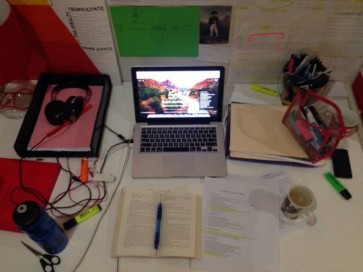 “My space is unique because I always have my pup with me, I have my laptop, a notebook and my bed, I don’t have a desk. So I sit on my bed and do everything, I’ll sit outside, I have to have music going, and I have pictures on my walls.”
“My space is unique because I always have my pup with me, I have my laptop, a notebook and my bed, I don’t have a desk. So I sit on my bed and do everything, I’ll sit outside, I have to have music going, and I have pictures on my walls.”
– Erica M.
“What makes my personal workspace unique is that I get to work at any time given. I feel comfortable and stress free. If I go out somewhere, I can take my work with me. I especially like it because I get to be home with family and grab a snack whenever I like. It can seriously be the couch, my bed, kitchen table and the patio except it really hot throughout the day. I’m also able to listen to music, helps motivate me more!”
– Salma U.
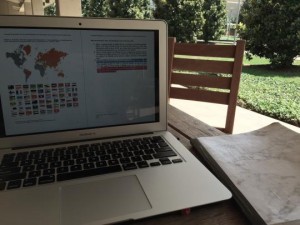 “What makes my workspace unique? Everything, I have everything I need next to me, not only that but I usually have my artwork scattered all over the table or hung up on the wall. I also add motivational quotes to help me get through the day, oh and my dog who is always with me.”
“What makes my workspace unique? Everything, I have everything I need next to me, not only that but I usually have my artwork scattered all over the table or hung up on the wall. I also add motivational quotes to help me get through the day, oh and my dog who is always with me.”
– Jennifer H.
“I have my laptop, binder with paper, an extra notebook, pens, pencils and such all in my laptop bag that I set up on the dining room table every day. I don’t ever work alone while having a daughter but I get good grades, learn to multitask and I get work done nicely and organized. I guess that’s all you can really ask for to get through school.”
– Kayde P.
These Simple Activities Will Keep Your Child Active This Summer While Keeping Your Sanity

Summer break.
It’s the most anticipated time for students. It’s that classic movie scene showing students staring at the ever-ticking clock, just waiting. Finally, that bell rings and all hell breaks loose as kids stampede through the halls, celebrating the start of their summer.
For parents? The story’s a little different. Sure, at first it sounds great. You’ll get to maybe enjoy the sun, perhaps go on vacation and just maybe even relax a little.
And at the beginning, you might. But it only takes weeks before those glittery hopes of summer dull into dealing with bored children who are somehow still not “too bored to do chores.” And that’s when it hits you: you miss school.
It’s not that you don’t love your children, it’s that both you and your children can only enjoy so many unstructured, unproductive days. Because let’s be honest, trying to entertain your kids for months is exhausting.
Of course, you should spend some time over the summer enjoying each other’s company and vacationing however you’re able. But to keep your sanity in those last pre-fall weeks of summer, we recommend trying out some of these simple, daily activities to keep your child’s brain active and ready for school.
Read!

Studies show that students on average return from summer break one month behind in learning than they were before the break.
Helping your student becoming prepared for the upcoming school year is as simple as setting time aside for reading.
Go to a library and view their summer reading lists. They will give fun, interesting books to read that are at the right reading level for your child.
For those students who aren’t bookworms, this is much easier said than done. Your child does not have to read a book.
Maybe they find the news comics entertaining or like a Children’s Highlights magazine. Whatever gets them reading something other than a Tweet or Snap that’s not filled with ‘texting lingo’ is incredibly productive.
Talk to them about what they read. What did they enjoy about it? What made it funny or sad or feel however they felt? This will help them better comprehend what they’re reading.
Implement math in your daily routines

Math is in everything you do. So why not make it a game?
Going to the store? Have your child see if they can accurately guess the total before the cashier rings you up. If they’re old enough, make sure they include sales tax.
When that gets easy, see if they can get the totals right if the costs were divided two ways, then three ways, then four.
Baking is another great way to implement math. Just for kicks, have them help you double a recipe.
When you play games as a family, try some card games that include math, like Yahtzee, Skip-BO or 31.
Find little ways you can implement math and be sure to include your child whenever possible over the summer.
Get out and explore whenever possible

If you take some time to get outside and engage your mind, it will do much good for everyone in your house, and make your student better prepared in the fall.
Living in Southern California means there are boundless opportunities places to explore.
Head somewhere educational every now and then. A museum, a science center an animal rehabilitation facility can all be great fun while learning something new.
Sign up for a summer learning program

Enrolling your child in a summer learning program will not only help them stay on track for fall, it makes scheduling and implementing routines much more doable.
You know when to plan your vacations based on free time available and routines are set for a couple weeks while your child is enrolled in summer courses.
Whether it’s an academic program or an athletic camp, summer tracks are a great way to keep your child active.
Elite has partnered with multiple schools and vendors throughout Southern California, so you’ll be able to find the right program that’s close by. You can learn more about our Summer Learning Track here.
Quality time makes all the difference

We know your children’s improvements are largely accredited to you.
We also want to thank you for your hard work on behalf of your students. You have changed their lives and changed their future in immeasurable ways.
During the summer, one of the most important things you can do to help your student is to spend quality time with them.
Quality time doesn’t always have to be academic, and certainly doesn’t need to be expensive.
Even if it’s just going to the park and throwing a Frisbee, that creates a child-parent bonding that’s beyond the norm of going to work, coming home, cooking dinner, watching TV and waking up to the same thing.
When you do those kinds of things, your child is more likely to follow through with the things you ask them to do.
Don’t be afraid to use those times as reinforcements. When they do well in math class or have a good behavior report, go and have a day out somewhere like the beach or ride bicycles, something to celebrate the triumphs of the child.
When you do these things, you become more than just someone who is a mom or dad. You become someone your kid appreciates and doesn’t want to let you down.
All we’re saying, really, is to keep doing what you’re doing.
A few tips to make the most of your Fourth of July

With kids, holidays don't always go as planned.
Fourth of July, is almost here, and with such a special birthday coming, we hope you're able to relax and get ready to celebrate this special birthday.
To help you get ready, we've put together some great tips to make the most out of this year's Fourth of July.
Tip #1 Invest in a fan
A fan serves an even greater purpose than keeping you cool. The moving air is also a natural mosquito repellent. With a fan, you can enjoy the great outdoors feeling cooler and without swatting mosquitoes all night.
Tip #2 Make your own "thunder calming shirt" for your pets before fireworks
Whether you plan to go out and watch fireworks or light some yourself, making sure your pets are calm before you go is important. If you don't want to buy a thunder jacket, check out this photo for an easy DIY.
Tip #3 Try some Fourth of July themed foods
To get you thinking about Independence Day, why not try cooking some patriotic foods? Bake a pie and decorate it with American colors, or even make a American flag cake. Grilling some traditional BBQ is always great, so long as it reminds you of childhood favorites and America!
Tip #4 Or make some simple Watermelon Juice
Watermelon is a great summertime treat that will go with just about any dish you serve this Fourth of July. This time around, try turning your favorite side dish into your favorite drink. For easy instructions, check out this recipe.
Tip #5 But more importantly, brush up on your history
What's an Independence Day celebration without taking some time to think about those who made it happen. This Fourth of July, take some time to reread the events that took place July 4, 1776 so you can truly know the meaning of the day's celebration.
Tip #6 Memorize at least one amendment in the Bill of Rights together
Speaking of Independence Day, why not celebrate your freedoms by learning more about them? The first ten amendments to the Constitution of the United States are known as the Bill of Rights, which lists out each freedom you are guaranteed as an American citizen.
Without the events that took place in 1776, there would be no Bill of Rights. So take some time with your student to memorize one amendment this Fourth of July. Besides, you'll be able to show off your knowledge at some point.
Tip #7 Drive somewhere nearby and soak up some local history
You might be thinking there isn't much history in California, compared to, say, Boston. But that's where you'd be wrong! While we may not be near Revolutionary War historical sites, taking time to appreciate history anywhere in the US certainly counts! Head to Old Town San Diego, explore a memorial or take some time at a museum.
Tip #8 Above all, spend the day with someone you care about
Of course, the best part of any holiday is that you can surround yourself with people you love. Whether it's a significant other or family and friends, be sure to spend your Independence with people you care about.
How to earn a high school diploma if you're over 18

Everyone deserves a great education.
For some, high school wasn’t that experience. Grades, social anxieties or life circumstances may have caused you to fall behind or drop out.
But that doesn’t mean you can’t earn your high school diploma.
Did you know you actually have until you’re 26 to graduate?
With Elite Academic Adult Education Academy, you can still earn your diploma.
About the Elite Adult Education Academy

A high school diploma holds more value than a GED. You can learn more about that here.
The Elite Adult Education Academy offers a combination of both virtual and in-person independent study programs for those who need more hands-on support to be successful. Students work with work with our highly qualified faculty and staff to customize their learning and prepare for the future.
With Elite, our students will:
- Have the opportunity to earn an accredited diploma
- Take core and enrichment classes
- Receive a blend of top-quality digital and traditional materials
- Get in-person instruction and support from an Elite Educator
- Have friendly, dedicated staff that supports the needs of independent learners
- Opportunities with Workforce Innovation and Opportunity Act (WIOA), job training and Career Technical Education (CTE) programs
Diplomas to fit your life
We know our adult students have lives and busy schedules. That’s why we offer a few different diploma options:
Traditional High School Diploma
210 credits to graduate
For students who enter the program with over 150 credits or would benefit from being in High School for longer than a year and are college bound.
Special Program Diploma
160 credits to graduate
For those who meet one of the following criteria:
- A student who is homeless
- A student who is a foster youth
- A student who is enrolled in a WIOA program
Special Circumstances Diploma
130 credits to graduate
For students who have extenuating circumstances that would merit an accelerated graduation path. Extenuating circumstances may include, but are not limited to the following:
- Student needs to graduate sooner in order to meet a deadline to transfer to a community college or trade school
- A pregnant student who needs to graduate prior to giving birth
- Student is close to aging out of the program
Other circumstances will be examined and eligibility determined on a case by case basis.
If you’re thinking it’s too late, it’s most likely not. Students 18-26 can still earn their high school diploma. Plus, you’ll have instructors and advisors with you every step of the way. You do your part, we’ll be sure to help you succeed.
To learn more about the Adult Education Academy, head here.
Six benefits of earning a high school diploma from home

Many know that homeschool and independent study is an option for elementary and junior high.
But we forget that there’s also more than one way to earn a high school diploma.
Sometimes, circumstances necessitate an alternative. Other times, you simply want another choice. Either way, earning a high school diploma from home can be a great option.
When it comes to the benefits, we could probably make a pretty hefty list. For your sake, we’ve narrowed to a few reasons.
The perks of earning a high school diploma from home
1. Sleep in (or wake up early)
Homeschool and independent learners can choose when they want to start their day.
If your student is one of those rare morning people (lucky you), they’re more than welcome to keep waking up at the crack of dawn. But if they (and you) prefer, they can start the day a little later. In other words, earning a high school diploma from home eliminates the stress of rushing to get out the door to school.
With Elite, your child can wake up early and knock out coursework, or sleep in and finish courses later in the day; it’s your choice.
2. When earning a high school diploma from home, your child learns from the comfort of, well…home
Elite’s digital classroom is wherever you have access to the internet. Whether your child’s preferred workspace is a comfy couch, a home desk or coffee shop, they can complete schoolwork in the place of their choice.
We also have an online community monitored by staff for students to join clubs and safely chat with other students online to get to know peers, so socializing won’t be a worry.
3. Teachers are a phone call away. Or email, or text, or instant message…
If your child is one who doesn’t like the burning stares from 30+ classmates that inevitably accompanies raising your hand to ask a question, we’ve got them covered.
Our teachers communicate with each student personally via phone calls, emails, texting, school announcements and instant messaging so that you can enjoy easy access to homework help from instructors.
4. Earning your high school diploma from home means you wear what you want
Dress code? We don’t know that word.
OK, you might not want them sitting in pajamas all day.
But the point is, there’s more freedom studying from home. Your student can wear a hat, chew gum, have mermaid hair, whatever you as the parent approves of. As long as they’re working hard to earn their diploma, it doesn’t matter to us what they decide to wear at home!
5. School is set to your schedule
If you’re at a traditional high school right now, we can probably guess what your student’s schedule looks like:
- 7:30 a.m. – 3 p.m. classes (6:30 if you’re in A or Zero Hour).
- 3 – 5 p.m. Sports practice, club meeting or other extracurricular activities.
- 5 – ‘who-knows’ p.m. finishing up homework or studying for an exam.
Here’s what a day in a life at Elite could look like:
- Wake up (when you want)
- Knock out about three hours of coursework, studying or participating in class discussions
- Take a break! Go explore, eat lunch or do something you love
- Finish up for a few more hours
- Go to work, spend time with family or enjoy your evening how you want!
Students need to spend about six hours a day. Many find that focusing for 2-3 hours on school work at a time with fun breaks in between makes the day go by much faster.
6. The curriculum is unlike any other (seriously)
Does your child get in trouble for falling asleep in class? We understand. School lectures can get boring.
That’s why we’ve created a curriculum that’s actually designed for today’s learners. Elite’s online curriculum is just as rigorous as your old school (we are accredited, of course), but we include gaming, videos, comic stories and more so that your student can actually enjoy learning.
How homeschool and independent study could help your child better manage anxiety

Anxiety is real. In fact, 1 in 20 children ages 6–17 years old frequently experience severe levels of anxiety.
For a student facing anxiety, traditional school can become overwhelming. There are facing crowds, dealing with drama, dreading tests, fearing to ask for help, the list goes on.
While it’s by no means a cure, homeschool and independent study could be a good solution for these teens.
Here’s why.
Studying from the comfort of home
Sometimes, anxiety is debilitating enough that it causes teens not to be able to leave the house. With Elite, staying at home doesn’t impact a student’s ability to learn. So, if the student is having a bad day, there is a potential for them to still do work. If they can’t, they have the ability to work with teachers to catch back up within the week.
Personalized support from teachers, counselors and advisors
Asking a teacher for help can be intimidating. There’s the fear of looking dumb or even just having to talk in front of a classroom.
Independent study and homeschool students find the lack of a physical classroom much appealing because they ask questions through email, phone calls and instant messaging. If they need extra support, the teacher can hold a 1-1 online session.
Socializing with classmates looks different
Digital natives are most comfortable connecting with friends online. Social media is integrated with their lives.
So clearly, if there is a safe way for these students to connect, wouldn’t that be their preferred method?
Students at Elite come from different walks of life. That opens opportunities to meet people. They also connect through digital class discussions, staff-monitored chats and student clubs. If they’d like, there are school events to attend in-person as well.
It’s quite a different method of making friends that we believe alleviates a lot of the traditional high school drama.
How to help your child manage anxieties with school
Be open with it
Talk to teachers and school counselors. They can’t help if they don’t know. Maybe math makes your child anxious, let them know! Maybe it’s the synchronous sessions, communicate that. Together, you can create baby steps to start accomplishing goals.
Modify your life
Oftentimes, an anxious student will want to limit themselves. Don’t let them limit, simply modify. If you were to take, say, your non-service dog out, you probably wouldn’t go to a fancy restaurant. That doesn’t mean you have to be confined. There are several places you can go with your furry friend: dog park, walks, even some food places.
Anxiety is similar. There will be things that feel like limitations, but you can help your student find ways to modify their life to manage anxiety. If you’re unsure, you have guidance counselors who can help.
Don’t isolate yourself or stop engaging
There might be days where your child can’t leave home, and that’s OK. Just try not to let that be a constant thing. Isolating yourself can lead to depression. It’s going to be difficult, but try and find ways where they can engage with others.
Maybe all your student can do is log in to synchronous sessions and type one message for the class to see. That’s OK; baby steps are key.
There are student clubs available at Elite as well. Have them try joining one of those, talk with students online and then work into meeting students in person.
Remember, you both have an opportunity to start fresh. Start with Elite.
Let it simply be a part of you that you manage daily
It’s truly OK to be anxious or to have anxiety. We all feel that from time to time. If your child is someone who frequently experiences high levels of anxiety, just treat it as something you have to manage daily.
We can help you overcome barriers

Elite has several students who came in order to overcome obstacles. Don’t let them stop you from earning your high school diploma. Whether you have to work, have a medical illness, are a teen parent or you went through trials that forced you to drop out, we can help. Don’t just take it from us; see the stories of some of our students below.
One Elite student who overcame barriers
“I have severe social anxiety and it makes it really hard for me to be in crowds, full classrooms, and full hallways. It’s hard for me to focus in class when there is so much going on around me and I get severely nervous. I became interested in homeschool because I felt my home was the best place for me since I know my family and they know what I’m struggling with.” – Samantha Q.
Please note: this article is not a medical diagnosis, nor are the tips provided above a cure. If you feel your child is experiencing signs or symptoms of anxiety, seek the help of a medical professional.
Five tips to help your child get better at math

Picture this:
Your child is sitting in the kitchen, staring at the table. He has a pile of math homework to start, but you just can't.
Finally, he asks for help. You take a look see a complex word problem. Your least favorite. You both want to quit.
Sound familiar?
You're not alone. In fact, 4 out of 10 Americans hate math.
If your student is among the four, we have some tips to help them get better at math and start enjoying homework. Our advice comes from a number of Elite Academic administrators, faculty and staff who are all highly qualified and experienced.
5 Ways to Get Better at Math
1. Implement math in your daily routine

The old saying, "practice makes perfect" rings true for math. There are a few easy ways you can practice math with your child while doing daily tasks. These tips come from Elite faculty:
- When you go to the grocery store, try adding up all the items in your cart with your child and see if the total you got is what shows up at the cash register.
- Then when your student gets good at that, try dividing it four ways: How much would the bill be if we split it up between mom, dad, brother and sister?
- Or try baking a new recipe, and calculate what it would take to double the recipe.
Math is found around you wherever you go; don’t stop exercising your brain!
2. Play games that require math

Again, it's all about incorporating math into everything you do. Even the fun things! There are several board games that include math in some form. Here are a few games you can play with family and friends:
You can also play a few video games created by StrongMind curriculum, which is offered at Elite. There are fun exciting graphic games you can play here.
3. Teach key phrases to make word problems simpler

Word problems can be daunting. But there are several common phrases you'll find in every word problem. And if your child can translate those, they'll get through word problems in a cinch! Here are a few common phrases:
Phrases meaning addition:
- Sum of
- Yields
- More than
- Combined
- Total of
- Together
Phrases meaning subtraction
- Decrease
- Difference between
- Less than
- Fewer than
Phrases meaning division
- Per
- Out of
- Ratio
Phrases meaning multiplication
- Of
- Times
Phrases meaning equals
- Yields
- Is (are/were/was)
- Sold for
Have your student take a deep breath before you start. Remind them that it might be daunting, but they can break it down. Find the key phrases and write the math symbols out. Eventually, they will be able to put together a math problem and solve it.
4. Memorize formulas through simple repetition

Have your student practice using the formulas again and again. After a lot of repetition, it gets easier to remember the formulas and the methods and then solving the problems becomes second nature! The second thing is to try to take careful notes and keep them– even after passing that math class. When your student gets into college and has to take additional math courses, you can always go back and refer to old notes if you forgot how something is done!
5. Remember, in order to get better at math, three things are required:
Improving in math requires patience, a good attitude and an open mind. Here is an encouraging thought from a math instructor.
"Yes, math can be difficult and even frustrating, so when you feel stuck, the mind wants to give up. But don’t give up! Have patience. Albert Einstein said, ‘It’s not that I am so smart. But I stay with the questions much longer.’ If you get upset about a math problem, take a deep breath, don’t rush. Try to look at math as a game or a puzzle rather than as a chore. With that perspective, math becomes doable and even fun!"
If you are struggling in math, the best thing you can do is reach out to your teacher for help. Your instructors are available via phone calls, emails, instant messages and online sessions to make sure you excel in your courses.
We will leave you with a few inspiring thoughts from online math instructor:
- You are not the only one who struggles, so do not panic.
- Stay organized, keep good daily notes especially keep the formulas handy-with clear meaning of each term in the formula. It is also useful to have a good reference such as BASIC MATH REVIEW ( here is one such resource)
- Do the workbook, checkpoint, exam questions step-by-step in your notebook--and not quickly jump to one of the answer choices--so that you can identify the error.
- Workbook practice is important in mastering a topic – so if needed, attend the live online sessions and get some help from your instructor.
- Keep pace by doing your daily lesson.
- Review your notes and especially the topics you struggled with, before taking the final exam.
How to tell if your child is overly stressed, and tips to manage it

It’s a different world our children live in today.
The technology and social connections immediately available to our youth truly are astounding. Of course, there is a lot of good that can come from it. After all, digital learning was not an option decades ago.
But there is something unique our kids face now, and that’s stress levels to that of an adult.
A poll conducted by the American Psychological Association (APA) showed that teens are experiencing greater stress levels than today’s adults. Teens reported feeling stressed at 5.8 on a scale of 10 (3.9 is considered the healthy average for teens). In contrast, adults reported their stress levels at 5.1 (3.6 is considered the healthy average for adults).
We’re not saying to pull your student out of all activities and get them to relax all day. However, there is something more alarming in this report:
The majority of teens did not feel that their stress levels were impacting their health. The majority also recognize their stress but do little to nothing to manage it.
Stress is a part of life. And if that’s the case, then there needs to be a healthy way to cope with it. To help you work with your student, we’ve put together some tips provided by guidance counselors in online education.
Signs your child might be experiencing high levels of stress

Psycom gives a few signs or symptoms to help you see if your teen is experiencing high levels of stress.
- Emotional changes beyond what appears “normal” for a maturing kid.
- Frequent stomach pains, headaches or other pains. The source of physical pains can greatly vary, but stress can certainly be a culprit.
- Changes in routines like eating, sleeping or other daily activities
- Your child seems more forgetful, can’t concentrate or is unusually careless
Tips to help your student manage stress
Tip 1: Get organized
You don’t want to create more stress by telling your child to get organized and clean up their space. But the truth is, having less clutter and a designated workspace can help the brain focus and potentially reduce stress.
Since we offer home school, virtual and flex school, your student has the advantage of working outside the traditional classroom. That can mean the comfort of home or maybe a coffee shop or by the pool (all great choices, by the way).
Make sure no matter where they work, they have a clean space and know where everything is to get work done and be productive.
Tip 2: Make sure they get enough sleep
Staying up all night to get a last-minute project done can be an OK thing to do once in a while. Sometimes, no matter how much we help them, our teens will still manage to procrastinate a large project, and losing sleep is the only option.
Not to mention, if you have a teenager, getting them to go to bed at a normal hour is no easy task.
Lack of sleep on a regular basis not only can cause stress, but it can also affect health. It impacts mood and mental health, while increasing chances of injuries and risky behavior.
Tip 3: Help them find ways to laugh it off
Things are not always going to go our way and that can be stressful. But sometimes it’s not up to us.
No matter how hard we work or how much we do to get something close to perfect, we will have bad moments in life that are out of our control. The key to managing stress in these situations is to “laugh it off” and move forward.
It’s important to allow your child time to express their feelings –vent– and even feel bad about it because we are all human. But for our own good, we need to spend more time looking for the positives that may have come from that situation and consider next time will be better.
Tip 4: Talk to an advisor
This is the most important tip. Elite counselors and advisors are here to help. It’s their jobs, and they’re passionate about it.
If you are unsure how to help your teen, reach out to them. They can help you map out a plan, and provide extra resources like counseling if needed.
Please note: These tips are only meant to help relieve stress levels. If you feel your child is experiencing depression, anxiety or has any other medical need, please seek professional help. In cases of emergencies, contact a California Crisis hotline.











